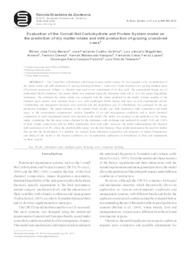Evaluation of the Cornell Net Carbohydrate and Protein System model on the prediction of dry matter intake and milk production of grazing crossbred cows.
Evaluation of the Cornell Net Carbohydrate and Protein System model on the prediction of dry matter intake and milk production of grazing crossbred cows.
Author(s): MORENZ, M. J. F.; SILVA, J. F. C. DA; AROEIRA, L. J. M.; DERESZ, F.; VASQUEZ, H. M.; LOPES, F. C. F.; PACIULLO, D. S. C.; TEDESCHI, L. O.
Summary: The Cornel Net Carbohydrate and Protein System model version 5.0 was assessed as for its prediction of dry matter intake and milk production of grazing lactating Holstein × Zebu cows. Eight lactating cows grazing elephant grass (Pennisetum purpureum, Schum., cv. Napier) were used in two experiments of 30 days each. The experimental design was of randomized blocks (subplots). Dry matter intake was estimated using the chromium oxide and in vitro dry matter digestibility techniques. The estimated dry matter intake was compared with the values predicted by the model. Extrusa samples of the elephant grass pasture were obtained from a cow with esophageal fistula during nine days in each experimental period. Carbohydrate and nitrogenous fractions were analyzed and the degradation rate of carbohydrate was estimated by the gas production technique. The inputs referring to the animals (body weight, age, milk production, milk composition and breed type), to the environment (temperature, relative humidity of air and management condition) and to feeds chemical composition in each experimental period were inserted in the model. The model was accurate on the prediction of dry matter intake, considering that the mean values obtained by the chromium oxide technique and predicted by model (2.45 and 2.46% of body weight, respectively) did not differ significantly from each other. However, the model underestimated the observed milk production in 62.4%, where the metabolizable energy was the first limiting. These results demonstrate the need for studies that provide the development of a database for tropical foods (chemical composition and dynamics of rumen fermentation) and fitting of the model to the tropical conditions, for its appropriate application in formulation of diets and supplements in these regions.
Publication year: 2012
Types of publication: Journal article
Unit: Embrapa Dairy Cattle
Keywords: Capim Elefante, Cromo oxido, Rotação de Cultura, Vacas lactantes
Observation
Some of Embrapa's publications are published as ePub files. To read them, use or download one of the following free software options to your computer or mobile device. Android: Google Play Books; IOS: iBooks; Windows and Linux: Calibre.
Access other publications
Access the Agricultural Research Database (BDPA) to consult Embrapa's full library collection and records.
Visit Embrapa Bookstore to purchase books and other publications sold by Embrapa.

